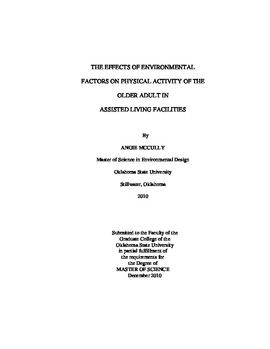| dc.contributor.advisor | Russ, Randall | |
| dc.contributor.author | McCully, Angie | |
| dc.date.accessioned | 2014-04-15T22:31:45Z | |
| dc.date.available | 2014-04-15T22:31:45Z | |
| dc.date.issued | 2010-12-01 | |
| dc.identifier.uri | https://hdl.handle.net/11244/9561 | |
| dc.description.abstract | The advances in medicine and technology have led to increased longevity for the aging adult (Crews, 2005). Maintaining the health of this increasing segment of the population has become an increasingly important issue since one third of the money spent on health care in America is being attributed to adults over 65 years of age (Davidson, 2009). The study was conducted on site at four assisted living facilities within the Stillwater area. Administrators at each facility were interviewed and given the details of the study. The name of their exercise coordinator was learned and a site visit was conducted and current exercise programs were reviewed. Two survey instruments were developed which assessed the demographics of the facility, and factors of the built and social environment as perceived by the administrators/exercise coordinators and the residents All of the facilities had a designated space for their residents to exercise and conducted weekly exercise classes. It was believed by all of the administrators/coordinators that the space was highly visible and conveniently located for the residents wanting to use it. Almost all the residents (30) responded their place of residence offered opportunities to be physically active, and 100% of residents responding indicated they would participate in an organized program to promote physical activity within their facility. The environmental factors that can assist in promoting physical activity are both social and built. Having friends and family members, facility staff and medical personnel participate in activities and organized programs with the residents was found to influence human behavior. Having a designated space to exercise, as well as the visibility and ease of access to this space was found to be a factor of the built environment impacting physical activity. The goal is to create a healthy community environment for the residents of an assisted living facility by designing environments that are more engaging. By providing social support people can be encouraged to develop healthier lifestyles and help to promote active living. | |
| dc.format | application/pdf | |
| dc.language | en_US | |
| dc.publisher | Oklahoma State University | |
| dc.rights | Copyright is held by the author who has granted the Oklahoma State University Library the non-exclusive right to share this material in its institutional repository. Contact Digital Library Services at lib-dls@okstate.edu or 405-744-9161 for the permission policy on the use, reproduction or distribution of this material. | |
| dc.title | Effects of Environmental Factors on Physical Activity of the Older Adult in Assisted Living Facilities | |
| dc.type | text | |
| dc.contributor.committeeMember | Lyon, Melinda | |
| dc.contributor.committeeMember | Swinney, Jane | |
| osu.filename | McCully_okstate_0664M_11249.pdf | |
| osu.college | Agricultural Sciences and Natural Resources | |
| osu.accesstype | Open Access | |
| dc.description.department | Environmental Sciences Program | |
| dc.type.genre | Thesis | |
| dc.subject.keywords | barriers to physical activity in the older adult | |
| dc.subject.keywords | built environmental factors effecting physical activity | |
| dc.subject.keywords | motivators to physical activity in the older adult | |
| dc.subject.keywords | physical activity in the older adult | |
| dc.subject.keywords | social environmental factors effecting physical activity | |
